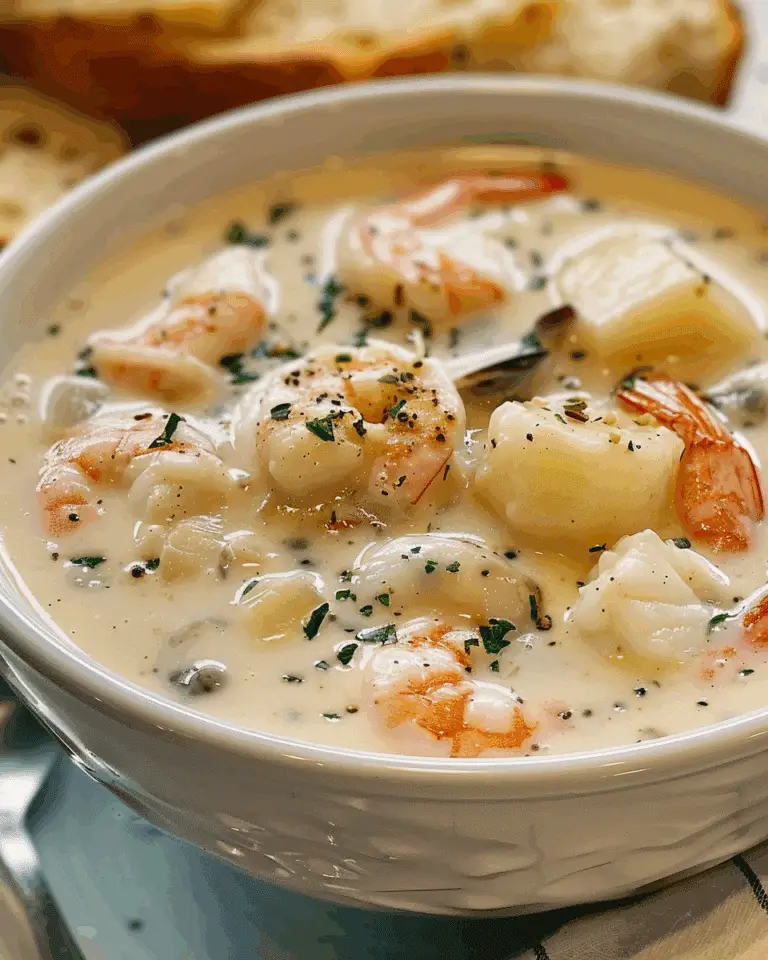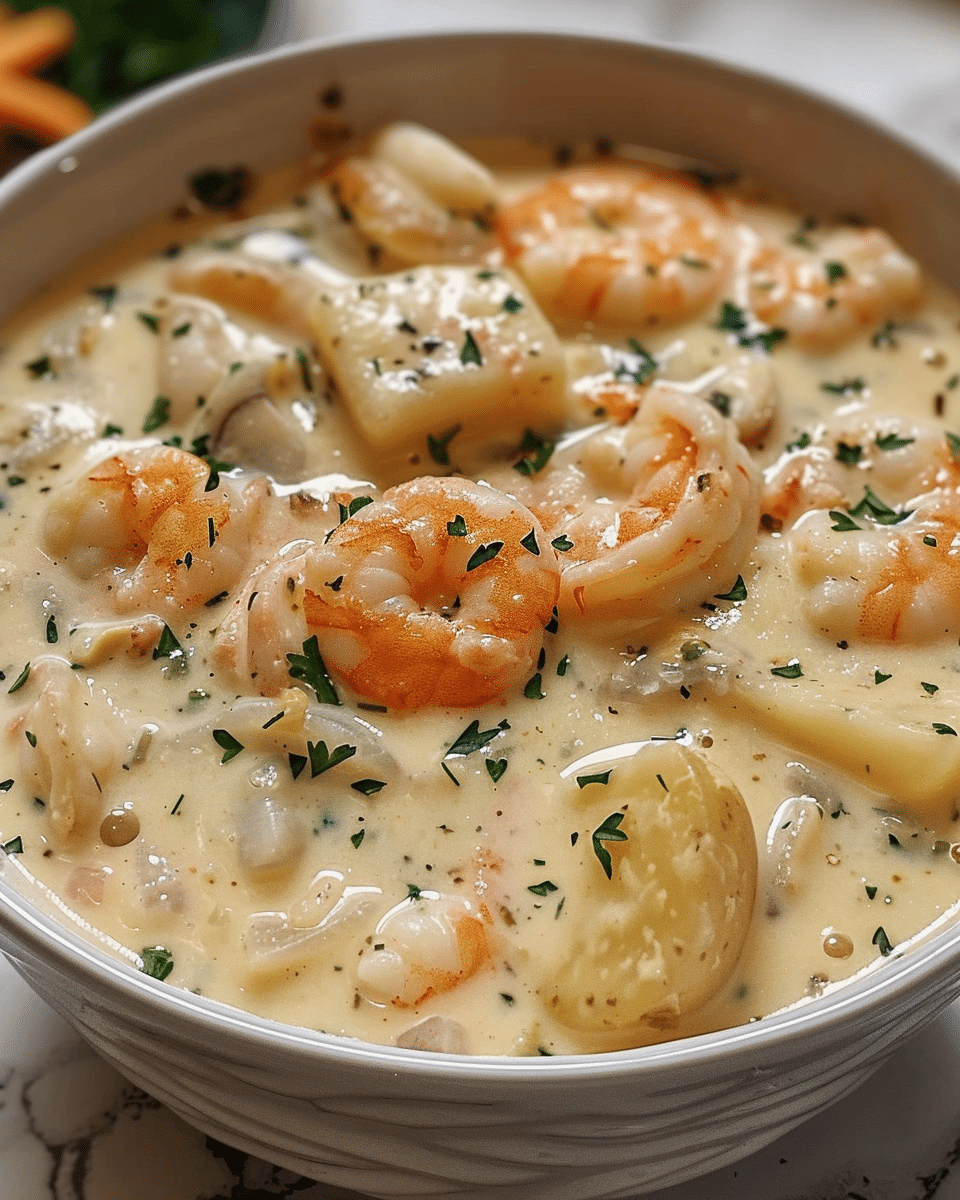A rich, creamy Atlantic-inspired soup filled with tender seafood, vegetables, and herbs. This classic Maritime chowder brings the taste of Canada’s east coast right to your kitchen with its perfect balance of fresh seafood and hearty ingredients.
Why You’ll Love This Recipe
This Nova Scotia Seafood Chowder is the ultimate comfort food that combines the best of Canadian coastal cuisine. You’ll love the rich, creamy broth that’s loaded with tender chunks of potato and a generous mix of seafood. It’s surprisingly easy to make yet impressive enough for special occasions. This authentic Maritime recipe is versatile – you can use whatever seafood is freshest at your market. The depth of flavor will make you feel like you’re dining at a seaside restaurant in Halifax, and it comes together in just 30 minutes, making it perfect for both weeknight dinners and weekend entertaining.
Ingredients
(Tip: You’ll find the full list of ingredients and measurements in the recipe card below.)
Unsalted butter creates the rich foundation for this chowder, providing a silky texture and helping to build flavor from the very beginning as you sauté the vegetables.
Onion, celery, and carrot form the aromatic base (known as mirepoix) that gives the chowder its depth of flavor. These vegetables slowly release their sweetness as they cook, creating a complex background note that supports the seafood.
Garlic adds a subtle pungent note that enhances all the other flavors without overpowering them. It’s an essential aromatic that pairs beautifully with seafood.
Potatoes are the hearty, starchy component that gives this chowder its substantial texture. They also help thicken the broth naturally as they release some of their starch during cooking.
Seafood or fish stock is crucial for an authentic seafood flavor. It infuses the entire chowder with a taste of the ocean that cannot be achieved with regular chicken or vegetable stock.
Bay leaf and dried thyme are the classic herbs that complement seafood perfectly. They add an aromatic quality that elevates the entire dish without competing with the delicate flavor of the seafood.
Black pepper adds a gentle heat that builds in the background. The slight spiciness works well with the creamy components.
Heavy cream and whole milk create that signature rich, velvety texture that defines a proper chowder. The combination provides luxurious mouthfeel while allowing the seafood flavors to shine.
Mixed seafood is the star of the show. The variety of textures and flavors from different seafood creates an interesting and satisfying eating experience. Using a mix rather than a single type makes each spoonful a delightful surprise.
Fresh parsley brightens the chowder with its clean, herbaceous notes and adds a pop of color to the finished dish.
Lemon juice is added at the end to cut through the richness with a touch of acidity, balancing the creamy elements and enhancing the fresh flavor of the seafood.
Directions
- Melt butter in a large pot over medium heat. Add onion, celery, carrot, and garlic, and sauté until softened (about 5-7 minutes).
- Add diced potatoes, seafood stock, bay leaf, thyme, and black pepper. Bring to a simmer and cook until the potatoes are tender (about 10-12 minutes).
- Reduce the heat to low, then stir in heavy cream and milk. Add the mixed seafood and simmer gently for 5-7 minutes, or until the seafood is just cooked through.
- Stir in fresh parsley and lemon juice. Taste and adjust seasoning if needed.
- Remove the bay leaf before serving. Serve hot with crusty bread or crackers.
Servings and Timing
This Nova Scotia Seafood Chowder recipe yields 6 generous servings, making it perfect for family dinners or small gatherings. Each serving contains approximately 430 calories. The recipe comes together relatively quickly with a prep time of 10 minutes and a cooking time of 20 minutes, totaling just 30 minutes from start to finish. This makes it an excellent option for weeknight dinners when you want something impressive without spending hours in the kitchen.
Variations
Dairy-Free Version: Replace the heavy cream and milk with full-fat coconut milk for a dairy-free alternative that still provides richness.
Smoked Fish Chowder: Add some smoked haddock or salmon along with the fresh seafood for a deeper, more complex flavor profile.
Spicy Seafood Chowder: Add a dash of cayenne pepper or a few dashes of hot sauce to give your chowder a pleasant heat.
Lobster Luxury: For special occasions, swap some of the mixed seafood for chunks of lobster meat to create an indulgent version of this classic.
Herb Variations: Try using fresh dill instead of parsley, or add a sprig of rosemary during simmering for a different aromatic profile.
Storage/Reheating
Refrigeration: Store leftover chowder in an airtight container in the refrigerator for up to 2 days. The flavors often develop further overnight, making it even more delicious the next day.
Freezing: While you can freeze this chowder, be aware that the texture of the seafood and potatoes may change slightly upon thawing. If planning to freeze, consider slightly undercooking the seafood. Freeze in individual portions for up to 1 month.
Reheating: Gently reheat the chowder on the stovetop over low heat, stirring occasionally. Avoid bringing it to a boil as this can cause the cream to separate and the seafood to become tough. If the chowder seems too thick after refrigeration, thin it with a little milk or stock.
Make-Ahead Tips: You can prepare the base of the chowder (everything except the seafood, cream, milk, parsley, and lemon juice) a day ahead. When ready to serve, reheat the base, add the remaining ingredients, and finish cooking according to the recipe.

FAQs
What’s the best type of seafood to use in this chowder?
The beauty of this recipe is its flexibility. Traditional Nova Scotia chowder often features local catches like haddock, cod, scallops, and lobster. Use the freshest seafood available in your area. For the best texture, include a mix of fish and shellfish, making sure to add more delicate items like shrimp or scallops toward the end of cooking to prevent overcooking.
Can I use frozen seafood instead of fresh?
Yes, frozen seafood works well in this recipe and is often more economical. Thaw it completely before adding to the chowder and reduce the cooking time slightly as frozen seafood tends to cook faster once thawed. Pat it dry with paper towels before adding to remove excess moisture.
Why is my chowder too thin?
If your chowder lacks thickness, you have several options. Let it simmer uncovered for a few extra minutes to reduce, mash some of the cooked potatoes against the side of the pot, or create a small slurry with 1 tablespoon of cornstarch mixed with 2 tablespoons of cold water and stir it into the simmering chowder.
Can I make this chowder ahead of time for a party?
Yes, but with some adjustments. Prepare the base through adding the potatoes and stock, then refrigerate. When ready to serve, reheat the base, then add the cream, milk, and seafood to finish cooking. This prevents overcooking the seafood and maintains the best texture.
What can I substitute for seafood stock?
If seafood stock isn’t available, you can use fish stock, clam juice, or even chicken stock in a pinch. To enhance the seafood flavor when using chicken stock, add the shells from your shrimp or a few fish trimmings while the broth simmers, then strain them out before proceeding.
Why did my cream curdle in the chowder?
Cream can curdle if added to a very hot liquid or if the chowder is boiled after adding the cream. To prevent this, reduce the heat before adding dairy components and maintain a gentle simmer rather than a boil for the remainder of the cooking time.
What’s the best way to serve this chowder?
Serve in warm bowls alongside crusty bread, oyster crackers, or biscuits for dipping. A small side salad with a light vinaigrette provides a nice contrast to the rich chowder. For an authentic Maritime touch, offer hot sauce at the table.
How can I make this recipe more economical?
Focus on seasonal seafood specials, consider using more white fish and fewer expensive shellfish, or incorporate canned clams or seafood. Frozen seafood medleys are often more affordable than buying individual types. You can also stretch the recipe by adding more vegetables like corn or peas.
Can I add different vegetables to the chowder?
Absolutely. While the classic mirepoix base is traditional, feel free to add corn, peas, leeks, or bell peppers. Just be mindful of cooking times—add firmer vegetables with the potatoes and quick-cooking ones later in the process.
Is there a low-fat version of this recipe?
You can reduce the fat content by using half-and-half instead of heavy cream, or even evaporated milk for a similar richness with less fat. Replace the whole milk with 2% or skim milk. While the texture won’t be quite as luxurious, you’ll still have a delicious chowder with fewer calories.
Conclusion
This Nova Scotia Seafood Chowder captures the essence of Atlantic Canadian cuisine with its perfect balance of fresh seafood, creamy broth, and hearty vegetables. More than just a soup, it’s a celebration of coastal flavors that brings warmth and comfort to any table. Whether you’re serving it for a special occasion or a cozy family dinner, this chowder is sure to become a cherished recipe in your collection. The versatility of ingredients means you can adapt it to what’s available while maintaining its authentic character. From the first spoonful to the last, this chowder delivers a memorable taste experience that will transport you straight to the Maritime provinces, no matter where you’re enjoying it.
Print
Nova Scotia Seafood Chowder
A comforting and creamy seafood chowder from Nova Scotia, packed with mixed seafood, vegetables, and a rich, flavorful broth.
- Total Time: 30 minutes
- Yield: 6 servings
Ingredients
- 2 tablespoons unsalted butter
- 1 small onion, finely chopped
- 1 celery stalk, diced
- 1 carrot, diced
- 2 cloves garlic, minced
- 3 cups diced potatoes (Yukon Gold or red potatoes)
- 4 cups seafood or fish stock
- 1 bay leaf
- 1 teaspoon dried thyme
- ½ teaspoon black pepper
- 1 cup heavy cream
- 1 cup whole milk
- 1 ½ lbs mixed seafood (shrimp, scallops, haddock, cod, or clams)
- ¼ cup fresh parsley, chopped
- 1 tablespoon lemon juice
Instructions
- Melt butter in a large pot over medium heat. Add onion, celery, carrot, and garlic, and sauté until softened (about 5-7 minutes).
- Add diced potatoes, seafood stock, bay leaf, thyme, and black pepper. Bring to a simmer and cook until the potatoes are tender (about 10-12 minutes).
- Reduce the heat to low, then stir in heavy cream and milk. Add the mixed seafood and simmer gently for 5-7 minutes, or until the seafood is just cooked through.
- Stir in fresh parsley and lemon juice. Taste and adjust seasoning if needed.
- Remove the bay leaf before serving. Serve hot with crusty bread or crackers.
Notes
- Use fresh seafood for the best flavor, but frozen seafood can also work as long as it is properly thawed.
- Adjust the seasonings to taste, and feel free to add additional herbs or spices for a flavor boost.
- Serve with crusty bread or crackers for a complete meal.
- Prep Time: 10 minutes
- Cook Time: 20 minutes
- Category: Soup
- Method: Stovetop
- Cuisine: Nova Scotian
- Diet: Low Calorie
Nutrition
- Serving Size: 1 serving
- Calories: 430 kcal
- Sugar: 4 g
- Sodium: 720 mg
- Fat: 25 g
- Saturated Fat: 15 g
- Unsaturated Fat: 8 g
- Trans Fat: 0 g
- Carbohydrates: 20 g
- Fiber: 2 g
- Protein: 30 g
- Cholesterol: 120 mg


